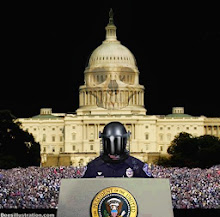21 July 2010
Top Secret America
Labels:
9/11,
America,
Bohemian Grove,
Conspiracies,
Federal Reserve,
Freemasons,
Illuminati,
israel,
Secret Societies,
Skull and Bones,
The Obama Fraud,
War is a Racket,
World Shadow Government,
Zionism
19 July 2010
Ocean Therapy Solutions
Providing Global Solutions for Oil Recovery
http://www.ots.org/ * John Houghtaling II * Patrick N. Smith * Kevin Costner * Eric M.V. Hoek
16 July 2010
Medical Mafia
DYING TO BE ‘CURED’ …
… THE DAILY CARNAGE OF ‘MODERN MEDICINE’
The odds of dying in hospital from ‘human error’ are 33,000 times greater than the risk of dying in an air crash
Other St Mary’s horror stories that I picked up this week from health professionals include:
•The patient who went to St Mary’s for a simple test, but the needle broke. Two days later they amputated his right leg; a day later they amputated his left leg because of gangrene and the next day he died, aged 58.
• Another patient who went to St Mary’s casualty department was prescribed blood-thinning drugs. He told them that he was already on a blood thinner called Warfarin, but they said it was absolutely fine to take both. He went home, took one of the new pills, and bled to death in the chair.
• Another patient who went to St Mary’s casualty department was prescribed blood-thinning drugs. He told them that he was already on a blood thinner called Warfarin, but they said it was absolutely fine to take both. He went home, took one of the new pills, and bled to death in the chair.
The late Dr Tom Chalmers, a distinguished medical researcher, had it right when he said: ‘If doctors died with their patients, they'd take a great deal more care.’ I am not saying there are no good doctors or medical staff at St Mary’s hospital, or that it does not do some good work, but there are enough breathtaking examples of Keystone Cop incompetence – far more than enough – for the place to deserve a government health warning. But it is not alone worldwide, it’s often more like the norm. A former professional health investigator in the UK told me:
‘Oh my God the death rate in hospitals is monumental. When I was in investigation the death rate ran into tens of thousands through incompetence alone. I mean 6,000 people die of malnutrition in these places every year, and drug reactions probably claim another 70,000 lives.
Another thing – over 20,000 people don't even wake up from anaesthetics each year in the UK hospitals alone. The stats speak for themselves, and I've got shelves full of them. That's why when medics go on strike the death rate drops between 17.5% and 24% in under two weeks.’
What he says is supported by report after report in country after country. In the United States doctors and other medical staff are the third biggest cause of death after heart disease and cancer with upwards of a quarter of a million people dying in US hospitals every year from unnecessary surgery, medication and other errors, the effects of the drugs given to ‘help’ them, and infections picked up in hospital.
Labels:
America,
Conspiracies,
Corporation,
Covert Global Depopulation Policy,
Genetic engineering,
GM Genocide,
Health,
Human Rights,
Medical Mafia,
Monsanto,
Subversion,
Weapons of Mass Prescription
The Electric Universe
A brief introduction to some aspects of Plasma Cosmology, and the role electricity plays here on Earth.
http://www.holoscience.com
http://www.thunderbolts.info
http://www.plasmacosmology.net
13 July 2010
Truth must be discovered
There is no path to truth. Truth must be discovered, but there is no formula for its discovery. What is formulated is not true. You must set out on the uncharted sea, and the uncharted sea is yourself. You must set out to discover yourself, but not according to any plan or pattern, for then there is no discovery.
Discovery brings joy - not the remembered, comparative joy, but joy that is ever new. Self-knowledge is the beginning of wisdom in whose tranquillity and silence there is the immeasurable.
Discovery brings joy - not the remembered, comparative joy, but joy that is ever new. Self-knowledge is the beginning of wisdom in whose tranquillity and silence there is the immeasurable.
JKRISHNAMURTI
(Commentaries on Living Series I, My Path and Your Path)
Continuity
What has continuity can never be other than that which it is, with certain modifications; but these modifications do not give it a newness. It may take on a different cloak, a different colour; but it is still the idea, the memory, the word. This centre of continuity is not a spiritual essence, for it is still within the field of thought, of memory, and so of time. It can experience only its own projection, and through its self-projected experience it gives itself further continuity. Thus, as long as it exists, it can never experience beyond itself. It must die; it must cease to give itself continuity through idea, through memory, through word.
Continuity is decay, and there is life only in death. There is renewal only with the cessation of the centre; then rebirth is not continuity; then death is as life, a renewal from moment to moment. This renewal is creation.
JKRISHNAMURTI
(Commentaries on Living Series I Chapter 38, Continuity)
Multiplying universes: How many is the multiverse?
HOW many universes are there? Cosmologists Andrei Linde and Vitaly Vanchurin at Stanford University in California calculate that the number dwarfs the 10500 universes postulated in string theory, and raise the provocative notion that the answer may depend on the human brain.
The idea that there is more than one universe, each with its own laws of physics, arises out of several different theories, including string theory and cosmic inflation. This concept of a "multiverse" could explain a puzzling mystery - why dark energy, the furtive force that is accelerating the expansion of space, appears improbably fine-tuned for life. With a large number of universes, there is bound to be one that has a dark energy value like ours.
Calculating the probability of observing this value - and other features of the cosmos - depends on how many universes of various kinds populate the multiverse. String theory describes 10500 universes, but that just counts different vacuum states, which are like the blank canvases upon which universes are painted. The features of each canvas determine what the overall painting will look like - such as the laws of physics in that universe - but not the details.
Thanks to the randomness of quantum mechanics, two identical vacuum states can end up as very different universes. Small quantum fluctuations in the very early universe are stretched to astronomical scales by inflation, the period of faster-than-light expansion just after the big bang. These fluctuations lay down a gravitational blueprint that eventually determines the placement of stars and galaxies across the sky. Small differences in the form of these fluctuations can produce a universe in which the Milky Way is slightly bigger, or closer to its neighbours.
So just how many of these different universes can inflation's quantum fluctuations produce? According to Linde and Vanchurin, the total is about 101010,000,000 - that's a 10 raised to a number ending with 10 million zeros (arxiv.org/abs/0910.1589). Suddenly string theory's multiverse of 10500 universes is looking rather claustrophobic.
It might be, however, that this number is irrelevant, and that in a world ruled by quantum physics what matters is how many universes a single observer can distinguish. "Before quantum mechanics," says Linde, "we thought that 'reality' was a well-defined word." In classical physics, observers are irrelevant - we simply want to know how many universes exist.
According to quantum physics, observers affect the systems they measure (see "Restricted view" below). If observers are an integral part of the cosmic formula, then it may not matter how many universes exist - just how many a single observer can tell apart. If the observer is a person, that depends on how many bits of information the brain can process. "Based on the number of synapses in a typical brain, a human observer can register 1016," says Linde. That means humans can differentiate 101016 universes, which is much more manageable than the 101010,000,000 Linde and Vanchurin found to start with.
But does the human brain really play a role in making predictions in the multiverse? "This goes deep into philosophy," Linde says. "It's a slippery slope."
Cosmologist Alex Vilenkin of Tufts University in Boston is equally ambivalent. "It could be right that what is important is what an observer sees," he says. "But there might be things an observer doesn't see that are still there."
Restricted view
Quantum theory splits the world into two parts: the system under study and the rest of the world, which contains the observer. The system hovers in a ghostly state of near-existence made up of a host of possibilities until the observer makes a measurement - and so reduces this to a single reality.
Cosmology suffers from the paradox that no observer can be outside the universe - so the universe is doomed to spend eternity as nothing more than a vague possibility. The lesson of quantum cosmology is that we can't talk about the universe as a whole, but only what a given observer inside it might measure. Applying that lesson to the multiverse, Andrei Linde and Vitaly Vanchurin suggest that what matters is not the total number of possible universes, but the number of universes a single observer could distinguish.
If that observer is a human, the brain limits the amount of information they can register. But any observer - even an inanimate one such as a galaxy - is limited in the information it can store. These limitations in what observers can measure whittle down the number of universes that come into play in cosmological predictions. That means an observer might make a difference in explaining the value of things like dark energy.
CNN Gets New Logo
2053 Nuclear Explosions Conducted 1945-1998
Labels:
Conspiracies,
Earth Changes,
Earth Quakes,
Global Politics,
Mega Tsunami,
New World Order,
Nuclear Weapons,
Seismic (Tectonic) Warfare,
Tsunami,
War is a Racket,
Weapon of Mass Destruction,
Zionism
Subscribe to:
Posts (Atom)







































